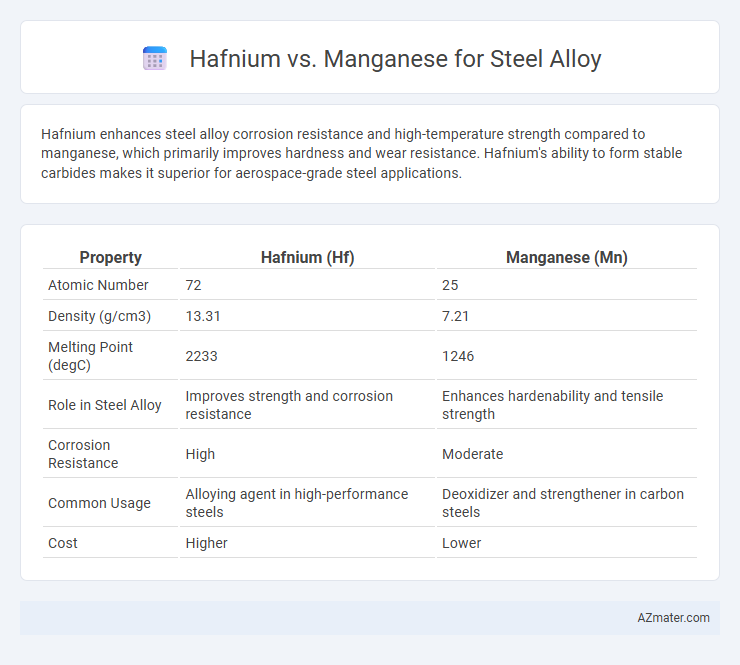Hafnium enhances steel alloy corrosion resistance and high-temperature strength compared to manganese, which primarily improves hardness and wear resistance. Hafnium's ability to form stable carbides makes it superior for aerospace-grade steel applications.
Table of Comparison
| Property | Hafnium (Hf) | Manganese (Mn) |
|---|---|---|
| Atomic Number | 72 | 25 |
| Density (g/cm3) | 13.31 | 7.21 |
| Melting Point (degC) | 2233 | 1246 |
| Role in Steel Alloy | Improves strength and corrosion resistance | Enhances hardenability and tensile strength |
| Corrosion Resistance | High | Moderate |
| Common Usage | Alloying agent in high-performance steels | Deoxidizer and strengthener in carbon steels |
| Cost | Higher | Lower |
Overview of Hafnium and Manganese in Steel Alloys
Hafnium enhances steel alloys by improving strength, corrosion resistance, and high-temperature stability due to its ability to form stable hafnium carbides and nitrides. Manganese acts as a vital deoxidizer and desulfurizer in steel, increasing toughness and wear resistance while preventing brittleness in low and high carbon steels. The distinct roles of hafnium and manganese contribute to optimizing mechanical properties and durability in specialized steel alloy applications.
Chemical Properties: Hafnium vs Manganese
Hafnium exhibits exceptional corrosion resistance and high melting point (about 2233degC), making it ideal for enhancing steel alloys exposed to extreme environments. Manganese, with a lower melting point (1246degC) and strong affinity for oxygen and sulfur, improves steel hardness and deoxidizes impurities during steel production. Chemically, hafnium's stability and oxidation resistance differ significantly from manganese's reactivity and role as a crucial alloying element for mechanical strength and wear resistance in steel.
Role in Steel Alloy Production
Hafnium enhances steel alloy production by improving high-temperature strength, corrosion resistance, and creep resistance, crucial for aerospace and nuclear applications. Manganese plays a significant role in steel manufacturing by acting as a deoxidizer and desulfurizer, improving hardness, tensile strength, and wear resistance. Both elements contribute uniquely to alloy properties, with hafnium optimizing performance in extreme environments, while manganese supports overall steel quality and durability.
Effects on Mechanical Strength
Hafnium enhances steel alloy mechanical strength by improving grain refinement and increasing resistance to creep deformation at high temperatures. Manganese contributes to tensile strength and hardness by promoting solid solution strengthening and improving work hardening capacity. The combination of hafnium and manganese can optimize steel alloys for superior durability and toughness in demanding applications.
Corrosion Resistance Comparison
Hafnium enhances steel alloy corrosion resistance by forming a stable oxide layer that protects against oxidation and pitting in harsh environments, outperforming manganese in high-temperature and marine applications. Manganese primarily improves steel's strength and hardness but contributes less significantly to corrosion resistance, making hafnium a superior choice where durability against corrosive agents is critical. Steel alloys with hafnium exhibit prolonged lifespan and reduced maintenance costs due to enhanced resistance to chemical attack and environmental degradation.
Impact on Steel’s Heat Resistance
Hafnium significantly enhances steel's heat resistance due to its ability to form stable carbides that improve grain boundary strength at high temperatures. Manganese, while essential for improving steel's hardenability and tensile strength, offers limited benefits to heat resistance compared to hafnium. The addition of hafnium in steel alloys results in superior performance in high-temperature environments, making it ideal for aerospace and power generation applications.
Cost and Availability Factors
Hafnium is significantly more expensive than manganese due to its rarity and complex extraction process, limiting its use in steel alloys primarily to specialized high-performance applications. Manganese, abundant and cost-effective, is widely used in steel production to improve hardness and wear resistance while maintaining affordability. Availability of manganese ensures steady supply and lower costs, making it the preferred choice for large-scale steel alloy manufacturing.
Industrial Applications and Use Cases
Hafnium enhances steel alloys by improving oxidation resistance and maintaining mechanical strength at high temperatures, making it ideal for aerospace turbine components and nuclear reactors. Manganese increases steel hardness and tensile strength while improving wear resistance, which is crucial for construction equipment, automotive parts, and heavy machinery. Both elements are essential in industrial steel production, with hafnium favored for high-performance, high-temperature applications and manganese used broadly for its cost-effectiveness and strength enhancement.
Environmental and Safety Implications
Hafnium in steel alloys offers superior corrosion resistance and thermal stability, reducing the need for frequent replacements and lowering environmental waste. Manganese, while essential for improving hardness and toughness, can pose health risks during processing due to toxic dust and fumes. Choosing hafnium over manganese may enhance worker safety and decrease environmental impact through more sustainable alloy performance and reduced hazardous emissions.
Future Trends: Innovations in Steel Alloying
Hafnium is gaining attention in steel alloying due to its exceptional grain refinement and high-temperature stability, enhancing steel's durability and resistance in extreme conditions. Manganese remains critical for its cost-effective strength improvement and hot-working properties, but future innovations are exploring hafnium's potential to create advanced, high-performance steel alloys with superior oxidation resistance. Emerging research aims to combine manganese's affordability with hafnium's metallurgical benefits to develop next-generation steel alloys optimized for aerospace and energy sectors.

Infographic: Hafnium vs Manganese for Steel Alloy
 azmater.com
azmater.com